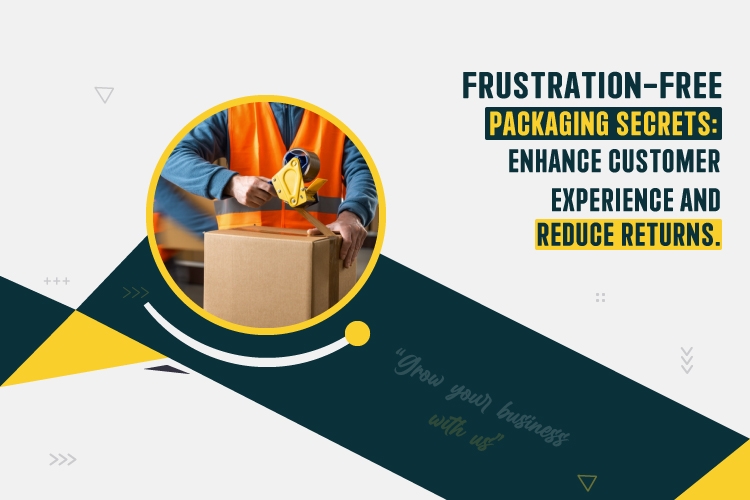Frustration-Free Packaging Secrets, Enhance Customer Experience and Reduce Returns.

In today’s competitive e-commerce landscape, packaging is more than a protective shell—it’s a pivotal touchpoint in the customer journey. A staggering 40% of consumers cite difficult-to-open packaging as a key frustration, leading to negative brand perceptions and increased returns. Enter frustration-free packaging: a design philosophy prioritizing ease, efficiency, and sustainability. This article unveils the secrets to leveraging such packaging to delight customers, reduce returns, and future-proof your brand.
Frustration Free Packaging is more than just a trend; it’s a movement towards greater efficiency, sustainability, and customer satisfaction.
Frustration-free packaging (FFP) reimagines traditional packaging by eliminating unnecessary complexity. Born from Amazon’s 2008 initiative to combat “wrap rage,” FFP focuses on:
-
Simplicity: Minimal layers, easy-open features.
-
Eco-Friendly Materials: Recyclable, biodegradable, or compostable options.
-
Perfect Fit: Right-sized packaging to prevent damage and waste.
-
Safety: Non-toxic, secure enclosures to protect products.
By aligning with consumer demands for convenience and sustainability, FFP bridges the gap between unboxing joy and operational efficiency.
The Triple Win: Benefits of Frustration-Free Packaging
-
Elevated Customer Experience
Unboxing is a make-or-break moment. FFP enhances this experience through:-
Intuitive Design: Tear strips or magnetic closures replace knives and scissors.
-
Aesthetic Appeal: Clean, minimalist designs that mirror brand values.
-
Safety: Reduced risk of product damage or personal injury.
Example: A cosmetics brand using magnetic-latch boxes saw a 25% rise in social media shares due to photogenic unboxing.
-
-
Reduced Return Rates
Returns cost U.S. retailers $816 billion in 2022, with damaged goods being a top cause. FFP mitigates this via:-
Secure Fit: Custom-sized compartments prevent movement during transit.
-
Durable Materials: Corrugated cardboard or molded pulp cushions fragile items.
Stat Alert: Dell reduced packaging-related damages by 20% after adopting FFP.
-
-
Sustainability and Brand Loyalty
67% of consumers prefer eco-conscious brands. FFP supports this through:-
Waste Reduction: Eliminating excess plastic and filler.
-
Circular Economy: Using materials like mushroom foam or seaweed-based plastics.
Case Study: IKEA’s shift to plant-based packaging boosted its sustainability score by 30%, enhancing customer loyalty.
-
Secrets to Mastering Frustration-Free Packaging
-
Simplify the Design
-
Less is More: Use single-material packaging to ease recycling.
-
Modular Templates: Create adaptable designs for varied product sizes.
-
-
Choose Smart Materials
-
Biodegradable Options: Cornstarch packing peanuts or recycled paper.
-
Durability Tests: Conduct drop tests to ensure material resilience.
-
-
Right-Size Your Packaging
-
Custom Inserts: 3D-printed molds or die-cut cardboard for snug fits.
-
Algorithmic Tools: Software like Packsize optimizes dimensions in real-time.
-
-
Integrate Easy-Open Features
-
Tear Tabs: Laser-scored lines for effortless opening.
-
Reusable Closures: Magnetic lids or drawstring bags for multi-use appeal.
-
-
Test, Iterate, Improve
-
User Feedback: Surveys or focus groups to identify pain points.
-
A/B Testing: Compare return rates between FFP and traditional packaging.
-
Real-World Success Stories
-
Amazon’s FFP Program: Partnering with 2,000+ brands, Amazon reported a 35% drop in returns and 70,000+ tons of waste saved since 2008.
-
Patagonia’s Recycled Packaging: By switching to 100% post-consumer materials, the brand cut carbon emissions by 15% and saw a 12% sales boost.
-
Glossier’s Pink Experience: Signature pink, easy-open mailers turned deliveries into Instagram moments, driving a 40% increase in referral traffic.
Conclusion: The Future is Frustration-Free
As consumers demand seamless experiences and sustainable practices, frustration-free packaging emerges as a strategic imperative. By adopting FFP, brands can reduce costs, foster loyalty, and position themselves as industry leaders. Start small—audit your current packaging, engage customers for feedback, and iterate toward a design that marries form, function, and responsibility. The unboxing moment isn’t just an interaction; it’s an opportunity to turn buyers into advocates.
- Questions and Answers
- Opinion
- Motivational and Inspiring Story
- Technology
- True & Inspiring Quotes
- Live and Let live
- Focus
- Geopolitics
- Military-Arms/Equipment
- Segurança
- Economy/Economic
- Art
- Causes
- Crafts
- Dance
- Drinks
- Film/Movie
- Fitness
- Food
- Jogos
- Gardening
- Health
- Início
- Literature
- Music
- Networking
- Outro
- Party
- Religion
- Shopping
- Sports
- Theater
- Health and Wellness
- News
- Culture

